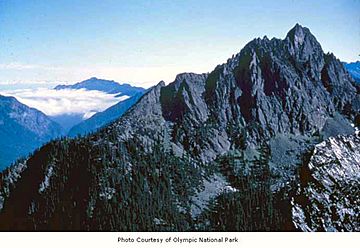Piro's Spire facts for kids
Quick facts for kids Piro's Spire |
|
|---|---|
 |
|
| Highest point | |
| Elevation | 6,259 ft (1,908 m) |
| Prominence | 739 ft (225 m) |
| Geography | |
| Location | Jefferson County, Washington, United States |
| Parent range | Olympic Mountains |
| Topo map | USGS Mount Steel |
| Geology | |
| Age of rock | Eocene |
| Type of rock | basalt |
| Climbing | |
| First ascent | 1947 Don Dooley, Elvin Johnson, Norma Johnson |
| Easiest route | Scrambling Class 3 via West Fork Dosewallips Trail |
Piro's Spire, also known as Piros Spire, is a tall, pointy mountain peak. It stands 6,259-foot (1,908-metre) high. This peak is made of a type of rock called basalt. You can find it in Jefferson County, Washington state.
Piro's Spire is part of the Olympic Mountains. It is located inside Olympic National Park. The closest higher peak is Diamond Mountain, which is about 1.86 miles (3 km) to the west. Both peaks are smaller parts of a bigger mountain group called the Mount Anderson massif. Piro's Spire is the peak farthest to the east in this group.
History of Piro's Spire
The first time anyone climbed to the top of Piro's Spire was in 1947. Three climbers named Don Dooley, Elvin Johnson, and Norma Johnson made this first ascent.
Elvin Johnson gave the peak its name. He named it after his good friend and climbing partner, Robert F. Piro. Robert Piro used to work as a fire guard at a nearby place called Dose Meadows in 1941. Sadly, Robert Piro was a soldier in the 85th Regiment of the Tenth Mountain Infantry Division. He was killed during World War II in Italy.
Climate Around Piro's Spire
Piro's Spire is located in a marine west coast climate zone. This type of climate is found in western North America. Most of the weather systems that bring rain or snow start over the Pacific Ocean. They then travel northeast towards the Olympic Mountains.
When these weather systems reach the Olympic Mountains, the tall peaks force the air upward. As the air rises, it cools down and drops its moisture. This process is called Orographic lift. Because of this, the Olympic Mountains get a lot of rain or snow, especially in the winter.
During the winter, the weather is usually cloudy. However, in the summer, high pressure systems over the Pacific Ocean often bring clear skies. The best months to climb Piro's Spire are usually from June to September because the weather is more favorable. Any rain or snow that falls on the mountain eventually flows into streams that lead to the Dosewallips River.



